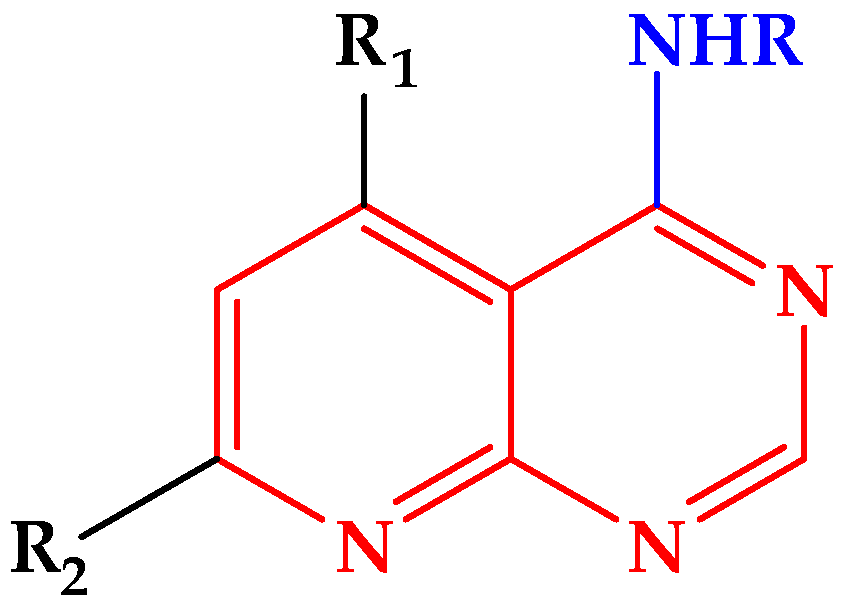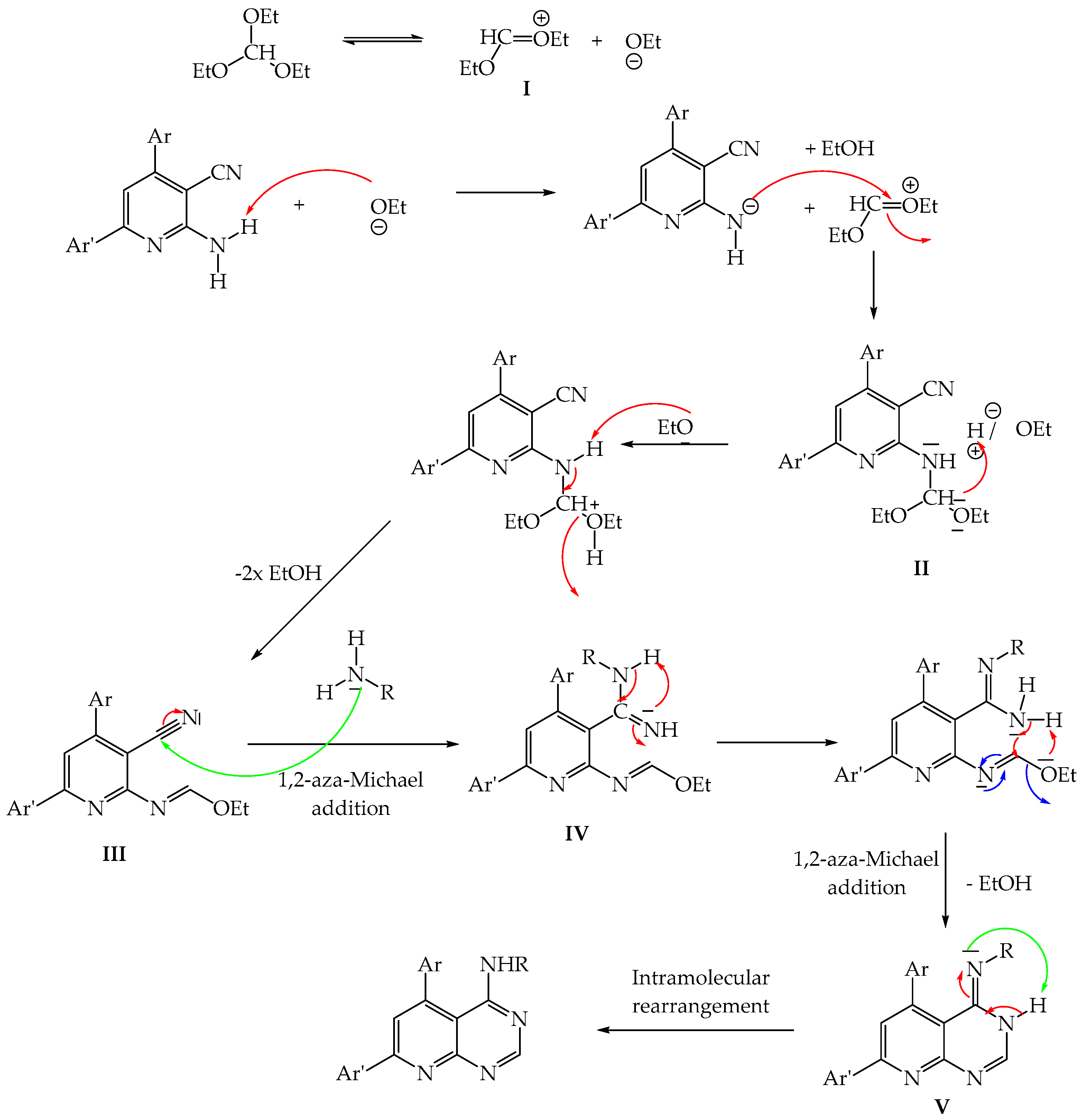Multicomponent, Solvent-Free Synthesis of 4-Substituted Aminopyrido[2,3-d]pyrimidines Derivatives †
Abstract
:1. Introduction
2. Results and Discussion
Synthesis of 4-Aminopyrido[2,3-d]pyrimidines Derivatives
3. The Proposed Mechanism for the Formation of 4-Aminopyrido[2,3-d]pyrimidines
1a–f
4. Experimental Procedure
5. Conclusions
Author Contributions
Funding
Institutional Review Board Statement
Informed Consent Statement
Data Availability Statement
Acknowledgments
Conflicts of Interest
References
- Buron, F.; Mérour, J.Y.; Akssira, M.; Guillaumet, G.; Routier, S. Recent advances in the chemistry and biology of pyridopyrimidines. Eur. J. Med. Chem. 2015, 95, 76–95. [Google Scholar] [CrossRef]
- Grivsky, E.M.; Lee, S.; Sigel, C.W.; Duch, D.S.; Nichol, C.A. Synthesis and antitumor activity of 2, 4-diamino-6-(2,5-dimethoxybenzyl)-5-methylpyrido [2,3-d] pyrimidine. J. Med. Chem. 1980, 23, 327–329. [Google Scholar] [CrossRef] [PubMed]
- Piper, J.; McCaleb, G.; Montgomery, J.; Kisliuk, R.; Gaumont, Y.; Sirotnak, F. Syntheses and antifolate activity of 5-methyl-5-deaza analogs of aminopterin, methotrexate, folic acid, and N10-methylfolic acid. J. Med. Chem. 1986, 29, 1080–1087. [Google Scholar] [CrossRef]
- Broom, A.D.; Shim, J.L.; Anderson, G.L. Pyrido [2, 3-d] pyrimidines. IV. Synthetic studies leading to various oxopyrido [2, 3-d] pyrimidines. J. Org. Chem. 1976, 41, 1095–1099. [Google Scholar] [CrossRef] [PubMed]
- Hanafy, F.I. Synthesis and antifungal activity of some new pyrido [2, 3-d] pyrimidines. Eur. J. Chem. 2011, 2, 65–69. [Google Scholar] [CrossRef]
- Panneerselvam, P.; Rather, B.A.; Reddy, D.R.S.; Kumar, N.R. Synthesis and anti-microbial screening of some Schiff bases of 3-amino-6, 8-dibromo-2-phenylquinazolin-4(3H)-ones. Eur. J. Med. Chem. 2009, 44, 2328–2333. [Google Scholar] [CrossRef] [PubMed]
- Alagarsamy, V.; Raja Solomon, V.; Sheorey, R.; Jayakumar, R. 3-(3-Ethylphenyl)-2-substituted hydrazino-3H-quinazolin-4-one Derivatives: New Class of Analgesic and Anti-Inflammatory Agents. Chem. Biol. Drug Des. 2009, 73, 471–479. [Google Scholar] [CrossRef] [PubMed]
- Le Corre, L.; Girard, A.-L.; Aubertin, J.; Radvanyi, F.; Benoist-Lasselin, C.; Jonquoy, A.; Mugniery, E.; Legeai-Mallet, L.; Le Merrer, Y. Synthesis and biological evaluation of a triazole-based library of pyrido [2, 3-d] pyrimidines as FGFR3 tyrosine kinase inhibitors. Org. Biomol. Chem. 2010, 8, 2164–2173. [Google Scholar] [CrossRef] [PubMed]
- Gangjee, A.; Adair, O.; Queener, S.F. Synthesis of 2, 4-diamino-6-(thioarylmethyl) pyrido [2, 3-d] pyrimidines as dihydrofolate reductase inhibitors. Bioorg. Med. Chem. 2001, 9, 2929–2935. [Google Scholar] [CrossRef] [PubMed]
- Shakir, M.A.; Jaafar, A.A.; Rafid, M.M.H. Synthesis and Preliminary Antimicrobial Activity of New Schiff Bases of Pyrido [1,2-A] Pyrimidine Derivatives with Certain Amino Acids. Med. Chem. 2014, 22, 635–639. [Google Scholar] [CrossRef]
- Mohamed, T.; Mann, M.K.; Rao, P.P. Application of quinazoline and pyrido [3,2-d] pyrimidine templates to design multi-targeting agents in Alzheimer’s disease. RCS Adv. 2017, 7, 22360–22368. [Google Scholar] [CrossRef]
- Wang, D.W.; Li, Q.; Wen, K.; Ismail, I.; Liu, D.D.; Niu, C.W.; Wen, X.; Yang, G.F.; Xi, Z. Synthesis and Herbicidal Activity of Pyrido [2,3-d] pyrimidine-2,4-dione-Benzoxazinone Hybrids as Protoporphyrinogen Oxidase Inhibitors. J. Agric. Food Chem. 2017, 65, 5278–5286. [Google Scholar] [CrossRef] [PubMed]
- Baba-Ahmed, I.; Kibou, Z.; Daoud, I.; Belhadj, F.; Belarbi, L.; Daich, A.; Choukchou-Braham, N. Synthesis, Molecular Docking and ADME-TOX Studies of New Tacrine Analogs as Promising for Alzheimer’s Disease Therapy. Curr. Org. Chem. 2022, 26, 1218–1233. [Google Scholar] [CrossRef]
- Belhadj, F.; Kibou, Z.; Vázquez-Tato, M.P.; Seijas, J.A.; Choukchou-Braham, N. Highly Efficient Approach of the Synthesis of New Cromeno[2,3-d]pyrimidine Derivatives. Chem Proc 2022, 4. [Google Scholar]
- Belhadj, F.; Kibou, Z.; Benabdallah, M.; Aissaoui, M.; Rahmoun, M.N.; Villemin, D.; Choukchou-Braham, N. Synthesis and Biological Evaluation of New Chromenes and Chromeno [2,3-d] pyrimidines. S. Afr. J. Chem. 2021, 75, 150–155. [Google Scholar] [CrossRef]
- Belhadj, F.; Kibou, Z.; Cheikh, N.; Choukchou-Braham, N.; Villemin, D. Convenient access to new 4-substituted aminopyrido [2, 3-d] pyrimidine derivatives. Tetrahedron Lett. 2015, 56, 5999–6002. [Google Scholar] [CrossRef]
- Graebin, C.S.; Ribeiro, F.V.; Rogério, K.R.; Kümmerle, A.E. Multicomponent Reactions for the Synthesis of Bioactive Compounds: A Review. Curr. Org. Synth 2019, 16, 855–899. [Google Scholar] [CrossRef]



| Product | Primary Amine | Yield (%) |
|---|---|---|
| 1a | Benzylamine | 85 |
| 1b | Butylamine | 79 |
| 1c | Butylamine | 71 |
| 1d | Cyclohexylamine | 69 |
| 1e | Phenylethylamine | 65 |
| 1f | Tryptamine | 61 |
Disclaimer/Publisher’s Note: The statements, opinions and data contained in all publications are solely those of the individual author(s) and contributor(s) and not of MDPI and/or the editor(s). MDPI and/or the editor(s) disclaim responsibility for any injury to people or property resulting from any ideas, methods, instructions or products referred to in the content. |
© 2023 by the authors. Licensee MDPI, Basel, Switzerland. This article is an open access article distributed under the terms and conditions of the Creative Commons Attribution (CC BY) license (https://creativecommons.org/licenses/by/4.0/).
Share and Cite
Belhadj, F.; Kibou, Z.; Seijas, J.A.; Vázquez-Tato, M.P.; Choukchou-Braham, N. Multicomponent, Solvent-Free Synthesis of 4-Substituted Aminopyrido[2,3-d]pyrimidines Derivatives. Chem. Proc. 2023, 14, 113. https://doi.org/10.3390/ecsoc-27-16080
Belhadj F, Kibou Z, Seijas JA, Vázquez-Tato MP, Choukchou-Braham N. Multicomponent, Solvent-Free Synthesis of 4-Substituted Aminopyrido[2,3-d]pyrimidines Derivatives. Chemistry Proceedings. 2023; 14(1):113. https://doi.org/10.3390/ecsoc-27-16080
Chicago/Turabian StyleBelhadj, Fatima, Zahira Kibou, Julio A. Seijas, Maria Pilar Vázquez-Tato, and Noureddine Choukchou-Braham. 2023. "Multicomponent, Solvent-Free Synthesis of 4-Substituted Aminopyrido[2,3-d]pyrimidines Derivatives" Chemistry Proceedings 14, no. 1: 113. https://doi.org/10.3390/ecsoc-27-16080
APA StyleBelhadj, F., Kibou, Z., Seijas, J. A., Vázquez-Tato, M. P., & Choukchou-Braham, N. (2023). Multicomponent, Solvent-Free Synthesis of 4-Substituted Aminopyrido[2,3-d]pyrimidines Derivatives. Chemistry Proceedings, 14(1), 113. https://doi.org/10.3390/ecsoc-27-16080







